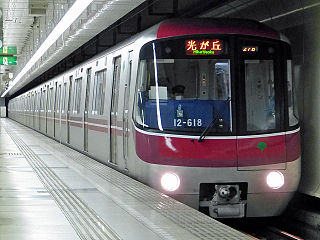
Kobe Station is a railway station in Chūō-ku, Kobe, Japan, operated by West Japan Railway Company. Although Kobe Station is the namesake of the city of Kobe, Kobe City Hall and the commercial center of Kobe is closer to Kobe-Sannomiya Station.

Akihabara Station is a railway station in Tokyo's Chiyoda ward. It is at the center of the Akihabara shopping district specializing in electronic goods.

The Osaka Metro is a major rapid transit system in the Osaka Metropolitan Area of Japan. It serves the city of Osaka and the adjacent municipalities of Higashiosaka, Kadoma, Moriguchi, Sakai, Suita, and Yao. Osaka Metro forms an integral part of the extensive mass transit system of Greater Osaka, having 123 out of the 1,108 rail stations (2007) in the Osaka-Kobe-Kyoto region. In 2010, the greater Osaka region had 13 million rail passengers daily of which the Osaka Municipal Subway accounted for 2.29 million.
The Japanese addressing system is used to identify a specific location in Japan. When written in Japanese characters, addresses start with the largest geographical entity and proceed to the most specific one. When written in Latin characters, addresses follow the convention used by most Western addresses and start with the smallest geographic entity and proceed to the largest. The Japanese system is complex and idiosyncratic, the product of the natural growth of urban areas, as opposed to the systems used in cities that are laid out as grids and divided into quadrants or districts.

The Japan Meteorological Agency, JMA, is an agency of the Ministry of Land, Infrastructure, Transport and Tourism. It is charged with gathering and providing results for the public in Japan that are obtained from data based on daily scientific observation and research into natural phenomena in the fields of meteorology, hydrology, seismology and volcanology, among other related scientific fields. Its headquarters is located in Chiyoda, Tokyo.

The Tokyo subway is a part of the extensive rapid transit system that consists of Tokyo Metro and the Toei Subway in the Greater Tokyo area of Japan. While the subway system itself is largely within the city center, the lines extend far out via extensive through services onto suburban railway lines.

Television Osaka, Inc. is a TV station affiliated with TXN in Osaka, Japan. The mascot character is "Takoru-kun" (たこるくん).
Daimaru (大丸) is a Japanese department store chain, principally located in the Kansai region of Japan. The chain is operated by Daimaru Matsuzakaya Department Stores, a subsidiary of J. Front Retailing. At one time Daimaru was an independent company, The Daimaru, Inc. (株式会社大丸), headquartered in Chūō-ku, Osaka.

The Toei Ōedo Line is a subway line in Tokyo, Japan, operated by the Tokyo Metropolitan Bureau of Transportation (Toei). It commenced full operations on December 12, 2000; using the Japanese calendar this reads "12/12/12" as the year 2000 equals Heisei 12. The line is completely underground, making it the second-longest railway tunnel in Japan after the Seikan Tunnel.

JOIX-DTV, branded as Yomiuri TV, is the Kansai region flagship station of the Nippon Television Network System, owned-and-operated by the Yomiuri Telecasting Corporation subsidiary of the eponymous Yomiuri Shimbun Holdings, Japan's largest media conglomerate; Yomiuri TV forms part of Yomiuri's main television broadcasting arm alongside Kantō region flagship Nippon TV, which owns a 15.89% share in the company. Founded as New Osaka Television Co. on February 13, 1958, and renamed Yomiuri Telecasting Corporation on August 1, the station started broadcasting on August 28 as the first TV station to be affiliated with Nippon Television Network Corporation. Its studios are located in the Osaka Business Park district of Osaka.
Sun Television Co. is a commercial television station headquartered in Kobe, Hyōgo Prefecture, Japan, and a member of the Japanese Association of Independent Television Stations (JAITS).

Nagamachi Station is a railway station on the Tōhoku Main Line in Taihaku-ku, Sendai, Miyagi Prefecture, Japan, operated by East Japan Railway Company and the Sendai Subway.
Yumehanna (ゆめはんな) is the collective nickname for the Chūō Line of the Osaka Metro and the Keihanna Line of the Kintetsu Railway in Osaka Prefecture and Nara Prefecture, Japan. The two lines operate through trains between Cosmosquare Station, the western terminus of the Chūō Line in Suminoe-ku, Osaka, and Gakken Nara-Tomigaoka Station, the eastern terminus of the Keihanna Line in Nara.

The Isewangan Expressway is a national expressway in the Tōkai region of Japan. It is owned and operated by Central Nippon Expressway Company.

Chikusa Station is an interchange railway station in Higashi-ku and Chikusa-ku, Nagoya, Aichi Prefecture, Japan, operated by Central Japan Railway Company and the Transportation Bureau City of Nagoya.

Abeno Cues Town (あべのキューズタウン) is the name of the Abeno A1 Area Urban Redevelopment Project A2 Building in Abeno-ku, Osaka, Japan.
The Kariba Route, signed as Route K3, is one of the tolled routes of the Shuto Expressway system serving the Greater Tokyo Area and is one of seven of the routes in the system serving Kanagawa Prefecture. The route is a 8.6-kilometer (5.3 mi) long radial highway running west from the Bayshore Route in Naka-ku, Yokohama near Haneda International Airport in Tokyo to the Yokohama Yokosuka Road and the Yokohama Shindō in Hodogaya-ku, Yokohama. Alongside the Yokohama Yokosuka Road, it connects central Yokohama to the Tōmei Expressway and the Bayshore Route which, in turn, connect to the rest of the Greater Tokyo Area and points beyond.
The Kobe Route, signed as Route 3, is one of the routes of the Hanshin Expressway system serving the Keihanshin area in Kansai, Japan. It is an intercity route that travels in an east to west direction from Osaka to Kobe, with a total length of 39.4 kilometers (24.5 mi).











